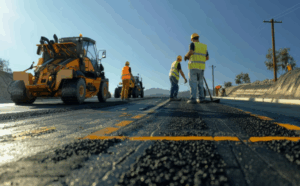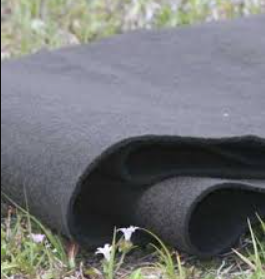Tuna Tekra Container Development with Ocean Non Woven Geobags
Introduction
The Tuna Tekra Container Terminal, located near Kandla in Kachchh, Gujarat, is one of India’s most significant port infrastructure development projects. Designed to handle millions of containers annually, this terminal plays a vital role in strengthening India’s logistics and trade capacity. As with any large-scale coastal infrastructure project, the challenge lies not only in construction but also in ensuring long-term stability, erosion control, and environmental protection.
Ocean Non Wovens, a trusted manufacturer and supplier of geosynthetics, contributed to this project by supplying 200 units of Ocean Non Woven Geobags (300 GSM). These geobags played a crucial role in providing coastal protection, structural reinforcement, and sustainability for the Tuna Tekra Container Development project.
Table of Contents
The Importance of Geosynthetics in Coastal and Port Infrastructure
Port and harbor developments like Tuna Tekra face some of the toughest engineering challenges—tidal fluctuations, strong wave actions, and long-term erosion. Traditional methods, such as stone pitching or concrete block revetments, often prove costly, time-consuming, and less sustainable in the long run.
This is where geosynthetics come into play. Products like geotextiles, geomembranes, and geobags provide flexible, cost-effective, and environmentally friendly alternatives for shoreline stabilization and erosion prevention. Studies have shown that geosynthetics reduce construction costs by up to 30–50% compared to conventional methods while ensuring better durability and performance [1].
Ocean Non Woven Geobags: Product Overview
The Ocean Non Woven Geobag 300 GSM is a specially designed geosynthetic product made from high-strength, UV-stabilized polypropylene fibers. Engineered with durability and environmental adaptability in mind, these geobags are widely used for:
- Coastal Protection: Acting as artificial reefs, revetments, and embankment protectors.
- Erosion Control: Preventing soil loss in riverbanks, coastlines, and port structures.
- Slope Stabilization: Providing reinforcement for embankments and dykes.
- Temporary and Permanent Structures: Functioning as flexible containers for sand and soil that integrate into the natural ecosystem.
For Tuna Tekra, 200 geobags (300 GSM) were supplied and installed, carefully filled and placed to withstand the hydraulic forces of the marine environment.
The Role of Geobags in Tuna Tekra Container Development
Tuna Tekra’s development required a strong erosion control solution due to the terminal’s proximity to tidal zones. The project demanded a cost-effective, quick-to-install, and long-lasting system. The Ocean Non Woven Geobag 300 GSM fulfilled these needs in several ways:
- Shoreline Protection:
Geobags were strategically placed to form a protective barrier against high-energy waves and tidal surges, reducing the risk of erosion along the reclaimed land. - Foundation Stability:
By acting as a separation and filtration layer, the geobags prevented the migration of fine soil particles, ensuring long-term stability of the container terminal’s foundation. - Eco-Sustainability:
Unlike concrete blocks, geobags allow natural vegetation and marine ecosystems to gradually integrate, creating an eco-friendly shoreline protection system [2]. - Rapid Installation:
The lightweight yet durable nature of the 300 GSM geobags made them easy to transport and install on-site, saving both time and labor costs.
Insights Often Overlooked in Case Studies
Most companies highlight only the technical performance of geosynthetics, but real-world applications reveal deeper insights:
- Settlement and Adaptability: Unlike rigid structures, geobags adapt to minor settlement and deformation without losing functionality. This flexibility is crucial for projects in soft soil conditions like those at Kachchh.
- Reduced Carbon Footprint: Using geobags reduces dependence on quarried stone or concrete, significantly lowering the carbon footprint of construction. With India targeting net-zero emissions by 2070 [3], this shift aligns with national sustainability goals.
- Maintenance Efficiency: While stone revetments often require periodic replenishment, properly installed geobags offer low-maintenance performance, making them economically beneficial over the project lifecycle.
- Community Impact: Coastal erosion directly affects local communities. Geobags in Tuna Tekra not only protected port infrastructure but also indirectly safeguarded nearby fishing communities by ensuring shoreline stability.
Conclusion & Promotional Note
The Tuna Tekra Container Development is a milestone in India’s port infrastructure, and Ocean Non Wovens is proud to have played a part in this ambitious project. By supplying 200 Ocean Non Woven Geobags (300 GSM), we helped ensure erosion control, environmental sustainability, and structural resilience for one of Gujarat’s most important container terminals.
At Ocean Non Wovens, we don’t just supply geosynthetics—we deliver engineering solutions that last. From geobags and geotextiles to geomembranes and erosion control systems, our products are designed to meet the highest industry standards. If you’re looking for innovative, cost-effective, and sustainable solutions for your next infrastructure or environmental project, Ocean Non Wovens is your trusted partner.
References:
[1] Koerner, R. M. (2012). Designing with Geosynthetics. 6th Edition. Xlibris Corporation.
[2] Pilarczyk, K. W. (2000). Geosynthetics and Geosystems in Hydraulic and Coastal Engineering. CRC Press.
[3] Government of India. (2021). India’s Net Zero 2070 Commitment at COP26.



